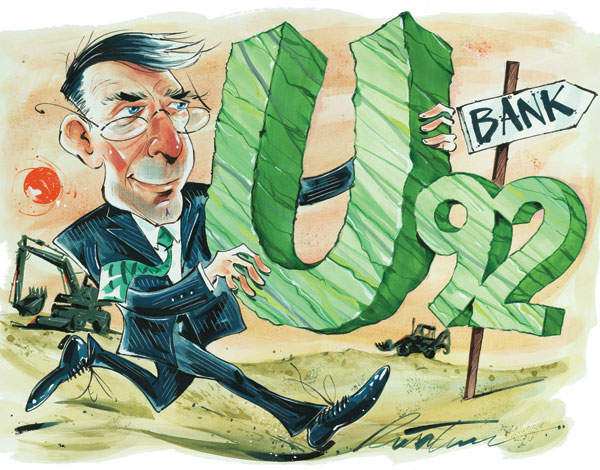

It is three and a half years since the tsunami off the east coast of Japan that caused a near-disastrous accident at the Fukushima power plant, following which the Japanese government shut down its entire nuclear fleet pending a safety review. That review is still under way and the drastic interruption of demand from this single source has led to an over-supply of uranium that has left the commodity in a bear market.
As Spear’s goes to press the spot price is languishing at around $28 to $28.75 per pound, and at this level it is uneconomic to extract uranium from the ground. Yet because the nuclear industry works on the basis of long-term contracts, the uranium producers are still delivering into contracts that were fixed at higher prices. Soon, however, all these contracts will be up for renewal, and producers are facing a world in which very few of the existing mines in production will actually be making any money, and this is likely to lead to a shortfall in global supply coming up to 2017 and 2018.
Various mining companies around the world have closed or mothballed mines and will only re-open them once the uranium price reaches a sustainable level at which it would be profitable to do so. Because of their low capital and operating costs, In Situ Recovery (ISR) or In Situ Leach (ISL) mining operations, which use chemical solutions to withdraw higher-grade ores from closer-to-surface deposits, have the greatest potential.
‘We are starting to see a very necessary bit of producer discipline coming through,’ says Will Smith, who manages the Geiger Counter fund for New City Managers. ‘Kazakhstan is by far the largest producer in the world right now, through its ISL mines, and it won’t be putting any new mines into production at this current price level. Increasingly, we see supply being challenged not only by price but also by security concerns.’ However, as a long-term uranium bull, Smith has been encouraged since Fukushima by the vigorous acquisition activity undertaken by the strategic players in uranium production, with an eye to a recovery in the price.
Precisely what makes the uranium sector attractive at the moment, argues Smith, is that ‘all the premium has been painfully bashed out of the explorers’. At the peak of the uranium price in 2007, there were around 500 listed companies exploring for uranium. Now there is only a small number left and they are trading either at or close to their cash levels. ‘I’d prefer not to have spent three years of a grim bear market getting to this position,’ says Smith, ‘but the total downside is baked into the explorers and the developers. I’m not a greedy man. I think an incentive price of $75 per pound would do wonders for the uranium market.’
The key driver of global demand remains China’s build-out of nuclear reactors to replace its numerous polluting coal-fired power stations, and Smith believes this might be significantly enhanced. ‘There’s one potentially interesting bullish scenario that just isn’t out there at the moment, and funnily enough this was in a BHP presentation about five years ago. At the moment China buys its reactors from abroad — but what happens when they start building their own and they get their cookie-cutter going? That would be a small increase in demand which I don’t think many people are modelling.’
In recommending mining companies to investors, Craig Foggo, a London-based analyst for the international resources-sector finance house RFC Ambrian, is more focused on the asset class of ISR or ISL uranium mines: ‘They’re very inexpensive to get up and running, and can be shut down and put on care and maintenance quite easily because they don’t have large overheads,’ he says. ‘You’re pretty limited out of the majors — you’ve got Paladin and Cameco. Frankly, you get more leverage out of your juniors such as Ur-Energy, Uranerz and Peninsula Energy, the Wyoming-based uranium producers.’
Foggo also recommends, as a speculative buy, Anatolia Energy, based in central Turkey, which has an ISR development at its Temrezli Project that looks set to produce uranium at a low cost for at least ten years.
Other than investing directly in uranium miners, there are five other ways to gain exposure to uranium. The Geiger Counter fund is the only managed fund that invests in the exploration, development and production of energy, primarily from uranium. Launched in 2006, it has a value of $21.9 million, and the minimum initial investment and charges are available on application.
‘We have quite a concentrated portfolio,’ explains Smith. ‘The market leader, Cameco, is very well financed with diverse operations across the fuel supply chain. That is the defensive play. Fission Uranium is one of the most exciting exploration stories of last year. In all our resource investing we’re always looking for the nascent, tier-one asset, and in Fission Uranium we think we’ve found one.
‘This is an asset that will probably end up in the hands of the majors, because it is such a high-grade asset.
‘You rarely see grades like this (ten, twelve, fifteen per cent) relatively close to surface — it’s under a very shallow lake — and in a jurisdiction that works: it’s in the Athabasca Basin, in Saskatchewan, Canada, where they understand uranium mining. Denison Mines has another development project in the Athabasca Basin, as well as assets in Africa that we think will have a value at a high uranium price. Stories such as these are the stand-outs in the uranium sector.’
Rather than go down the managed fund route, you might prefer to invest through an ETF. There are three to choose from. The Global X Uranium ETF (NYSEARCA: URA) holds uranium miners exclusively, whereas the other two, Market Vectors Nuclear Energy ETF (NYSEARCA: NLR) and the iShares S&P Nuclear Index Fund ETF (Nasdaq: NUCL), hold a mixture of miners and nuclear energy producers such as utility companies. Then again, NLR has a 34 per cent exposure to mining companies, 24 per cent to utilities and a 38 per cent exposure to industrials, whereas NUCL has only a 7 per cent exposure to miners, a 62 per cent exposure to utilities and a 30 per cent exposure to industrials.
If the demand for nuclear power rises significantly, all three ETFs are likely to do well, but if the demand for nuclear power remains much the same while the uranium price rises owing to supply constraints, then URA is likely to fare best, while NLR is likely to fare better than NUCL.
The fifth and perhaps most direct way to gain exposure to uranium is through Uranium Participation Corp (OTCPK: URPTF). Managed by Denison Mines, it is a holding company for the compounds uranium oxide and uranium hexafluoride. Shorn of the risk of exploration or production, it is a pure-play investment in the commodity. Denison charges a management fee of 1.5 per cent of any uranium it buys or sells, as well as $400,000 plus 0.3 per cent of the company’s uranium holdings (net asset value) beyond $100 million.
Will Smith believes he is right to remain bullish. ‘We are in a terrific situation where there is no investor interest, all the explorers have been hammered out over the last three years, and those that are left are clinging on. It’s always quite an exciting phase of the resource investor’s life. It won’t take much money to get these things really moving.’







